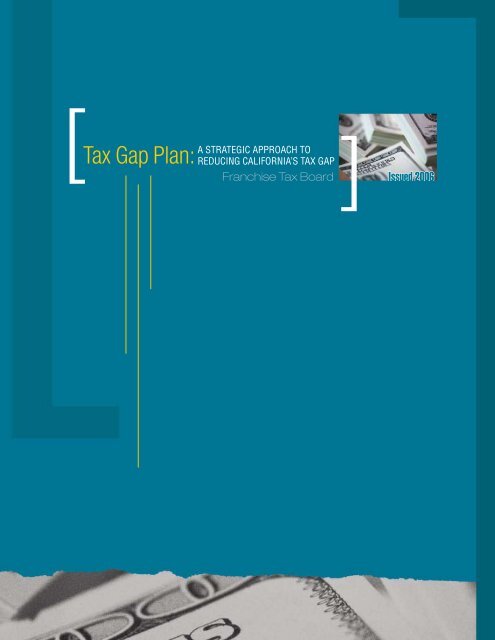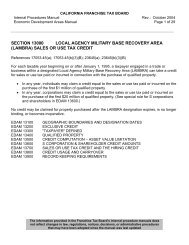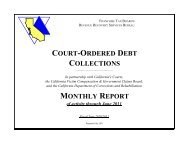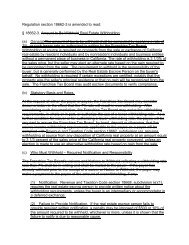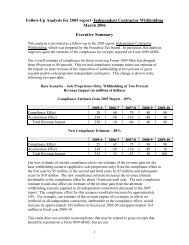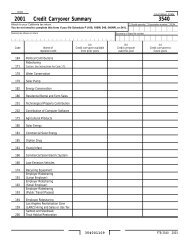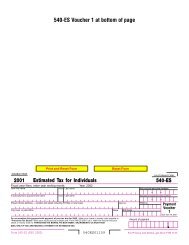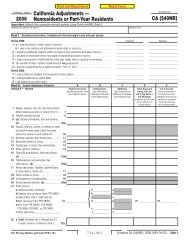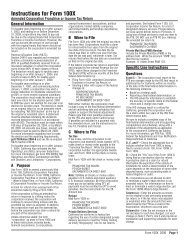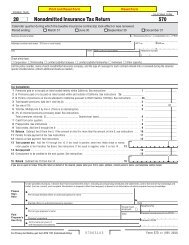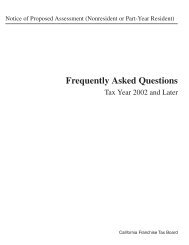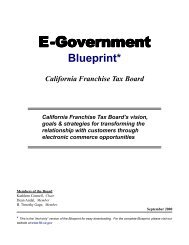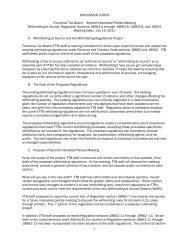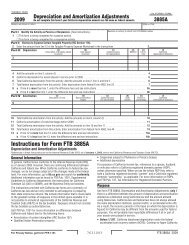Tax Gap Plan - Franchise Tax Board - California Franchise Tax Board
Tax Gap Plan - Franchise Tax Board - California Franchise Tax Board
Tax Gap Plan - Franchise Tax Board - California Franchise Tax Board
You also want an ePaper? Increase the reach of your titles
YUMPU automatically turns print PDFs into web optimized ePapers that Google loves.
<strong>Tax</strong> <strong>Gap</strong> <strong>Plan</strong>:<br />
A STRATEGIC APPROACH TO<br />
REDUCING CALIFORNIA’S TAX GAP<br />
Issued 2006
Letter From Steve Westly, State Controller<br />
I’m pleased to introduce the <strong>Franchise</strong> <strong>Tax</strong> <strong>Board</strong>’s plan to address <strong>California</strong>’s tax gap.<br />
Creating a tax system where every taxpayer pays the correct amount of tax—no more and<br />
no less—goes to the heart of our mission to fairly and effectively administer the State’s<br />
income taxes. Each year, however, <strong>California</strong> taxpayers pay $6.5 billion less in income<br />
taxes than they legally owe. Shrinking this “tax gap” is the goal of this plan.<br />
This new plan builds on a foundation of current, successful enforcement and customer<br />
service programs. Since 2004, the Voluntary Compliance Initiative (VCI) for abusive tax<br />
shelter participants and <strong>Tax</strong> Amnesty have brought in over $6 billion to <strong>California</strong>. These<br />
two programs demonstrate the impact that effective tools can have in addressing the tax<br />
gap. But current enforcement programs and initiatives haven’t done enough to narrow the<br />
tax gap. We must embark on a multi-year plan that addresses all of the root causes of the<br />
tax gap. Steps to increase overall confidence in the tax system and reduce the burden and<br />
complexity of complying with the tax laws are included in this approach.<br />
In developing this plan, FTB collaborated with academics, taxpayer groups, tax<br />
professionals, business representatives, legislative staff, and other stakeholders. These<br />
stakeholders deserve appreciation for contributing their time and expertise to improving<br />
<strong>California</strong>’s tax system. We now look forward to working with our stakeholders to take<br />
action and reduce <strong>California</strong>’s tax gap.<br />
Sincerely,<br />
STEVE WESTLY<br />
<strong>California</strong> State Controller<br />
Chair, <strong>Franchise</strong> <strong>Tax</strong> <strong>Board</strong>
3<br />
Table of Contents<br />
4<br />
5<br />
6<br />
8<br />
14<br />
15<br />
16<br />
22<br />
23<br />
INTRODUCTION: Most Of Us Do The<br />
Right Thing—We Pay Our <strong>Tax</strong>es<br />
ASSESSING THE TAX GAP: Who Is Not<br />
Paying <strong>Tax</strong>es?<br />
A STRATEGIC APPROACH TO DECREASING<br />
THE TAX GAP<br />
TAX GAP PLAN GOALS<br />
CRITICAL SUCCESS FACTORS<br />
CONCLUSION<br />
APPENDIX 1<br />
<strong>Plan</strong> Detail and Implementation Schedule<br />
APPENDIX 2<br />
<strong>Plan</strong>ning Process and Members of the<br />
Executive Officer Advisory <strong>Board</strong><br />
APPENDIX 3<br />
External Sources of Information
4<br />
INTRODUCTION:<br />
Most of us do the right thing—we pay our taxes<br />
Each year, about 14 million individuals and nearly one million businesses voluntarily file their tax returns and<br />
pay their <strong>California</strong> income taxes. This is 86 percent of all the income taxes owed. This is also the revenue that<br />
provides much of the funding for <strong>California</strong>’s public services. An additional three percent of income taxes owed is<br />
collected through FTB enforcement actions that compel payment of taxes not voluntarily paid.<br />
This still leaves a “tax gap”—the total amount of taxes owed but not paid—of about 11 percent in a typical year.<br />
This equals approximately $6.5 billion a year in unpaid taxes.<br />
PERCENTAGES OF TOTAL TAX OWED<br />
THE TAX GAP AND PAYMENTS FROM VOLUNTARY COMPLIANCE AND ENFORCEMENT ACTION<br />
Enforcement<br />
Action<br />
<strong>Tax</strong> <strong>Gap</strong><br />
3%<br />
11%<br />
86%<br />
Voluntary Compliance<br />
The failure by some to pay what they owe means that the rest of us bear an additional burden. This can come in<br />
the form of higher fees and taxes, fewer government services, or budget deficits—or all three.<br />
This <strong>Tax</strong> <strong>Gap</strong> <strong>Plan</strong> addresses the problem of unpaid taxes. The plan includes near-term and longer range<br />
actions. These actions, along with some already underway, will have immediate revenue effects. Over the next<br />
three years, the actions will bring in as much as $1.5 billion in taxes that today remain uncollected.<br />
Although we will probably never completely close the tax gap, we believe that the proposed approach will<br />
significantly reduce it.
ASSESSING THE TAX GAP:<br />
Who Is Not Paying <strong>Tax</strong>es?<br />
Our estimate of the State tax gap is based on the IRS estimate of the federal tax gap, adjusted for <strong>California</strong>.<br />
However, it is likely that the estimates are low. They are based on incomplete data and do not fully account for<br />
all taxes lost to the underground economy and abusive tax shelters, such as hiding income offshore. For example,<br />
fiscal years 2003-04 and 2004-05 saw revenues higher than typical years due to two special FTB programs.<br />
The Voluntary Compliance Initiative (VCI) brought in $1.4 billion from taxpayers seeking to avoid penalties by<br />
voluntarily paying taxes they had previously avoided through the use of abusive tax shelters. The <strong>Tax</strong> Amnesty<br />
Program brought in $4.8 billion from other taxpayers who used the opportunity to come into compliance with the<br />
provisions of tax law and thereby avoid penalties.<br />
According to the federal estimate, different segments of the population account for differing percentages of the tax<br />
gap. The chart below shows the estimated shares of the tax gap by filing segment and type of misreporting. Note<br />
that “PIT” stands for Personal Income <strong>Tax</strong>.<br />
FEDERAL TAX GAP PERCENTAGES<br />
ACCOUNTED FOR BY THE TYPE OF FILER AND NONCOMPLIANCE<br />
Understated tax – Corporations<br />
Overstated deductions,<br />
exemptions, credits – PIT<br />
Non-paying –<br />
PIT and Corporation<br />
Nonfiling – PIT<br />
8%<br />
12%<br />
11%<br />
11%<br />
21%<br />
37%<br />
Underreported income –<br />
PIT Business<br />
Underreported income –<br />
PIT Nonbusiness<br />
As the chart shows, the underreporting of income on Personal Income <strong>Tax</strong> returns contributes the largest portion<br />
of the tax gap. In fact, the underreporting of business income by personal income taxpayers makes up nearly 40<br />
percent of the total tax gap. The IRS estimates that the majority of this underreported income is from business<br />
sectors that do business largely in cash.<br />
Because so much of the tax gap is still unknown, it is a difficult issue to resolve. Over the years, FTB has<br />
continuously increased the total amount of taxes collected voluntarily and through enforcement. However, the<br />
percentage of taxes owed but not paid has remained constant because the amount of tax owed has also increased.<br />
This plan puts in place a framework for actions that can finally begin to decrease this persistent tax gap.<br />
4 5
6<br />
A STRATEGIC APPROACH<br />
TO DECREASING THE TAX GAP<br />
Our approach to reduce <strong>California</strong>’s tax gap is to address the primary causes—not just the symptoms—of<br />
the tax gap. We developed goals to address those primary causes and appropriate initiatives to achieve<br />
those goals. This approach balances “soft” approaches and enforcement-oriented approaches. Soft<br />
approaches, such as increasing taxpayer confidence and reducing burden and complexity, narrow the tax<br />
gap by increasing taxpayer willingness to voluntarily comply. Voluntary compliance is a key for making<br />
major inroads into the tax gap. As previously stated, typically, about 86 percent of <strong>California</strong>’s income tax<br />
revenue comes from taxpayers that voluntarily report and pay their taxes. Increasing that rate by just one<br />
percentage point from 86 to 87 percent would narrow the tax gap by about $500 million.<br />
Enforcement—taking action to compel payment and enforce penalties—also has an important role in<br />
reducing the tax gap. Enforcement increases the rate of voluntary compliance because it gives honest<br />
taxpayers confidence that cheaters get caught. It also deters those who would otherwise find cheating too<br />
tempting.<br />
In addition to balancing soft and enforcement actions, the plan also balances tactical, short-term actions<br />
with more foundational, long-term actions. Here is the difference between the two approaches: Tactical<br />
actions address immediate tax gap issues and generate short-term revenue, primarily through enforcement.<br />
In contrast, foundational activities seek to make lasting changes in taxpayer behavior to increase voluntary<br />
compliance. They also improve FTB’s capacity to respond to future tax gap challenges.<br />
By moving forward to implement new initiatives described in this plan and continuing existing efforts<br />
already underway, FTB expects to collect as much as $1.5 billion in tax revenue over the next 3-5 years<br />
from:<br />
• Nearly $1 billion from targeting abusive tax shelters.<br />
• About $200 million from increased audit activity, including speeding up certain amnesty-related audits.<br />
• About $300 million from new tax gap initiatives that fall into the tactical and foundational<br />
categories listed below.<br />
Tactical:<br />
1.<br />
2.<br />
3.<br />
4.<br />
5.<br />
“Increasing the rate of voluntary compliance by just one percentage point from 86<br />
to 87 percent would narrow the tax gap by about $500 million.”<br />
Conduct more audits.<br />
Focus on preparers that prepare problem returns and that promote sham,<br />
out-of-state incorporations.<br />
Audit issues related to independent contractors.<br />
Use more data sources to detect nonfilers.<br />
Expand the program to find certain business nonfilers.
Foundational:<br />
1.<br />
2.<br />
3.<br />
4.<br />
5.<br />
6.<br />
7.<br />
8.<br />
9.<br />
Target independent contractors with education and outreach to increase<br />
voluntary compliance.<br />
Promote tax compliance through a statewide education campaign based on the successful<br />
Amnesty campaign.<br />
Make changes to FTB programs based on direct input from taxpayers and other<br />
stakeholders on actions that will increase willingness to correctly report and pay taxes.<br />
Make FTB’s information return (1099) program—where those making payments to others<br />
report that information to FTB—easier so we receive more returns.<br />
Revise tax returns to include a line that shows total income covered by information returns.<br />
Devise better audit modeling for catching underreporting of income and enhance FTB’s<br />
ability to track evolving tax cheating approaches.<br />
Integrate FTB’s data systems to improve usefulness for enforcement and voluntary<br />
compliance initiatives.<br />
Increase criminal prosecution for significant abuses of the tax laws.<br />
Use taxpayer tips as leads to find significant noncompliance.<br />
The above actions are a balance of soft and enforcement approaches. When given the choice, FTB<br />
would always prefer to bring in taxes owed to the State through voluntary means rather than resorting to<br />
enforcement. Our recent experience with the tax amnesty and VCI programs indicates that encouraging<br />
voluntary compliance is not only less intrusive on taxpayers, but is also very cost effective. For example,<br />
for an investment of under $13 million, the VCI and the <strong>Tax</strong> Amnesty Programs brought nearly 175,000<br />
people into voluntary compliance and garnered $4.8 billion from tax amnesty and an additional $1.4<br />
billion from VCI in taxes that otherwise would not have been paid.<br />
However, FTB still needs enforcement methods when voluntary methods fail. We are seeing increasingly<br />
sophisticated techniques for hiding income, and cash businesses are moving further underground. For<br />
example, as of the end of March 2006, FTB’s abusive tax shelter efforts are currently addressing audit<br />
cases with estimated revenue of nearly $1 billion. These efforts required that we develop new audit<br />
methods to find transactions that did not exist 15 years ago.<br />
Regardless of the approach used, we need to be able to measure the success of our methods in decreasing<br />
the tax gap. We also need the resources and funding to pursue the tax gap plan initiatives. A more<br />
detailed explanation of these metrics as well as FTB’s funding request, is included in a separate Budget<br />
Change Proposal that has been submitted to the Department of Finance.<br />
7
8<br />
TAX GAP PLAN GOALS<br />
FTB’s plan contains six key goals, with each goal targeting a primary cause of the tax gap. The goals are<br />
shown on the following pages. For the specific initiatives, objectives, and timeframes for each goal, please<br />
refer to appendix 1.<br />
Goal 1<br />
Improve <strong>Tax</strong>payer Confidence in the <strong>Tax</strong> System<br />
Over the last 20 years, a growing number of studies have concluded that taxpayers’ willingness to<br />
voluntarily report and pay their full, legally-owed tax liabilities increases when they:<br />
• Have confidence that the tax agency uses fair procedures.<br />
• Perceive that the agency treats them with respect.<br />
• Believe that most taxpayers pay what they owe.<br />
It is also important that businesses, including large corporations, have confidence in the tax system.<br />
Willingness to honestly report and pay declines when this confidence is undermined. These<br />
conclusions are consistent with FTB’s experience with taxpayers, tax professionals, and taxpayer<br />
groups. In addition to the perceived fairness of tax agency procedures, it is also important that<br />
individuals and businesses regard paying taxes as part of being good citizens and understand the<br />
important role they play by paying the taxes needed to support essential services.<br />
“Last year, 87 percent [of taxpayers surveyed] said it was not acceptable at all to<br />
cheat, compared to 91 percent in 1999. We must stem this tide; not to do so would<br />
place the entire tax administration system in peril.”<br />
Mark Everson, IRS Commissioner, IRS Oversight <strong>Board</strong> Annual Report 2004
Goal 2<br />
Make <strong>Tax</strong>es Less <strong>Tax</strong>ing<br />
Estimates of taxpayers’ annual costs to comply with federal tax laws range from $75 to $265<br />
billion. We know less about the burden of complying with state tax laws. But we do know that the<br />
burden of complying with <strong>California</strong> tax laws increases when State requirements differ from federal<br />
requirements. That is, when they do not “conform” to federal requirements.<br />
This burden is not equal for all taxpayers. Estimates suggest that small businesses’ costs to comply<br />
with tax laws is a larger share of their total costs than it is for large businesses. In <strong>California</strong>, many<br />
businesses must deal with more than one State agency to meet all of their tax requirements. In<br />
addition, <strong>California</strong>’s diverse population suggests that a one-size-fits-all tax system will be easier for<br />
some taxpayers to navigate than others. Immigrants, seniors, college students, independent contractors,<br />
out-of-state taxpayers, and others have their own sets of unique circumstances. FTB needs to collect<br />
more information about different taxpayers’ needs to make it as easy as possible for all <strong>California</strong><br />
taxpayers to meet their tax obligations.<br />
Burden and complexity may increase the tax gap in several ways:<br />
•<br />
•<br />
•<br />
•<br />
Complex tax laws can cause well-intentioned, honest taxpayers to make inadvertent errors.<br />
Complex requirements may cause some taxpayers to simply choose not to take all the steps<br />
necessary to determine their true tax liability. This approach can lead taxpayers to underpay, but<br />
can also cause overpayment. Some taxpayers may even drop out of the tax system to avoid the<br />
cost of compliance.<br />
Complexity can lead to differing interpretations by taxpayers and tax administrators, which may<br />
undermine taxpayers’ perception of procedural fairness.<br />
More complex tax laws give dishonest taxpayers more opportunities to conceal tax evasion<br />
through complex schemes.<br />
The goal of reducing burden and complexity is also relevant to the prior goal of increasing taxpayer<br />
confidence in the tax system. Burden and complexity can erode taxpayer confidence, because<br />
taxpayers can view a complex system as less fair and lacking respect for them and their time.<br />
“…simpler taxes would generate more public support and thus should be an<br />
essential part of any effort to improve delivery of government services. The biggest<br />
complaint about the tax system for many people is not the amount of taxes they<br />
pay but rather the sheer, and seemingly needless, complexity of what appear to be<br />
everyday tax situations.”<br />
William H. Gale, Brookings Institute in testimony to Congress 2001<br />
9
10<br />
Goal 3<br />
Make It Harder to Cheat<br />
Studies show that people who think about cheating on their taxes mainly consider two things: the<br />
likelihood of getting caught and how much they’ll have to pay if they do get caught. Unfortunately,<br />
several economic trends are making it harder for FTB to track income and other tax information<br />
needed to detect cheating. These trends include globalization, electronic commerce, offshore banking,<br />
and an increase in the number of independent contractors. We also see evidence that business is<br />
increasingly conducted in cash to hide income.<br />
Information is key to detecting tax cheating. Compliance rates are highest where the IRS and FTB<br />
get data from employers and other third parties about income and other tax information. While FTB’s<br />
traditional enforcement approach has been to crosscheck this data with the information supplied on<br />
tax returns, newer tax cheating methods require that FTB uncover information that is left completely<br />
off the return. Sharing information across agencies and jurisdictions, as well as finding new sources<br />
of data, are increasingly important. Automated tools and systems provide the ability to examine and<br />
compare large quantities of data to detect noncompliance. In seeking information, FTB must guarantee<br />
taxpayers that we will continue to maintain all privacy principles and safeguards.<br />
“Consider what happened one spring evening at midnight in 1987: 7 million<br />
American children suddenly disappeared… It was the night of April 15, and the<br />
Internal Revenue Service had just changed a rule. Instead of merely listing each<br />
dependent child, tax filers were now required to provide a Social Security Number<br />
for each child. Suddenly, 7 million children—children who had existed only as<br />
phantom exemptions on previous year’s 1040 forms—vanished...”<br />
Malcolm Gladwell in Freakonomics
Goal 4<br />
Level the Playing Field for Businesses<br />
IRS tax gap studies show that tax cheating is much more common in some sectors of the economy than<br />
in others, and is generally the worst where taxpayers have the opportunity to conduct business in cash.<br />
When cheating becomes widespread, a snowball effect can occur. Margins in business are often small<br />
and difficult to maintain, so businesses have a temptation to duck tax obligations to help their bottom<br />
line. If most businesses underreport, then competitive markets squeeze prices downward to reflect<br />
lower costs from the tax cheating. Ultimately, the lower prices leave margins that cannot cover taxes<br />
and expenses, so businesses that pay taxes can no longer compete. They must join in underreporting or<br />
go out of business. Even where such market pressure has not developed, lack of confidence in the tax<br />
system may lead to lower levels of correct self-reporting in sectors where cheating occurs.<br />
Future State efforts must respond to this problem to help level the playing field for all businesses.<br />
This includes developing programs that will focus on business sectors where tax cheating has<br />
been identified and is putting honest businesses at a competitive disadvantage. Also, those specific<br />
businesses that are noncompliant with tax law should not be permitted to contract with the State.<br />
“… Additionally they don’t pay any payroll taxes on these people, don’t have<br />
to provide any benefits, and can use these savings to reduce the price of their<br />
products. We are beginning to be unable to compete…”<br />
Business owner in a letter to the State Controller<br />
11
12<br />
Goal 5<br />
Support High Standards in the <strong>Tax</strong> Professions<br />
<strong>Tax</strong> professionals play an important part in <strong>California</strong>’s tax system, preparing nearly 70 percent<br />
of <strong>California</strong>’s Personal Income <strong>Tax</strong> returns. <strong>Tax</strong> professionals understand tax laws and make<br />
fewer mistakes than non-professionals, which helps both taxpayers and FTB. However, honest tax<br />
professionals face increasing competition from unethical providers of tax services.<br />
<strong>Tax</strong> professionals have always felt pressure from clients who want to prepare returns that do not reflect<br />
the full amount of tax owed. Ethical tax professionals can sometimes lose business to unscrupulous<br />
preparers who are willing to help taxpayers cheat. For example, in 2005, some <strong>California</strong> tax<br />
professionals expressed frustration that FTB was not doing more to dispute the claims of out-of-state<br />
tax advisors offering to reduce taxes through sham corporations set up in other states. Narrowing the<br />
tax gap requires that FTB work closely with the tax professional community to understand the most<br />
effective ways to support ethical preparers.<br />
“Compliance with <strong>California</strong>’s complex tax laws requires representation of <strong>California</strong><br />
taxpayers by ethical and responsible tax service professionals at all levels.”<br />
<strong>California</strong> Society of CPAs
Goal 6<br />
Become More Innovative in Attacking the <strong>Tax</strong> <strong>Gap</strong><br />
When FTB and the IRS have effectively focused on specific categories of tax cheating, they have<br />
pushed evaders to use strategies that tax agencies have not yet learned to detect. The rise of abusive<br />
tax shelters in the past decade demonstrated this phenomenon. As tax agencies learned about abusive<br />
tax shelters, aggressive promoters continued to evolve complex financial transactions that are more<br />
difficult to detect. The indicators previously used to select tax returns for audit no longer work on these<br />
evolved transactions. Given the rapidly evolving nature of the tax gap, FTB must develop the ability<br />
to innovate and detect new modes of cheating. FTB’s ability to innovate will be crucial to reducing the<br />
tax gap over the long-term.<br />
“A balanced approach does not ignore areas of noncompliance simply because they<br />
are difficult to deal with. It includes creative approaches to intractable problems.<br />
And it does it on a solid foundation of research, so that valuable and limited<br />
resources are used wisely and effectively.”<br />
Nina Olson, The National <strong>Tax</strong>payer Advocate, in testimony to the Senate, July 2004.<br />
13
14<br />
CRITICAL SUCCESS FACTORS<br />
Making significant progress in closing <strong>California</strong>’s tax gap is a huge undertaking, and FTB recognizes that our<br />
commitment alone won’t make it happen. There are several factors we will need to address to be successful.<br />
We must partner with others. FTB cannot solve the tax gap problem alone. Others have a role and an interest<br />
in reducing the tax gap as well, and wise use of public dollars means building and leveraging partnerships with<br />
those who have relevant skills or insight into helping us reduce the tax gap. This includes elected officials, other<br />
government agencies, taxpayer groups, academic and other empirical researchers, tax professionals and their<br />
associations, software companies, and the business community.<br />
We must leverage federal efforts. A taxpayer’s decision to underreport income or overstate deductions is<br />
often made primarily to avoid federal income tax, because federal tax rates are generally three times as high as<br />
<strong>California</strong> tax rates. The IRS has recently announced that it believes as much as one-third of the tax gap may<br />
be recovered as a result of activities currently proposed at the federal level. Because federal income tax law<br />
generally serves as the basis for <strong>California</strong> tax law, <strong>California</strong> stands to benefit significantly from these federal<br />
tax gap activities.<br />
We must ask taxpayers and tax professionals what they think. As tax administrators, we see the tax<br />
system from the inside out—a critical perspective in figuring out how to close the tax gap, but not the only<br />
one. <strong>Tax</strong>payers, tax professionals, and other stakeholders bring a different perspective, which is also critical for<br />
understanding how we can take effective action. To understand the view of the tax system from the outside in,<br />
we must ask taxpayers and others their views about why there is a tax gap and how we can ensure every taxpayer<br />
pays the correct amount of tax.<br />
We must be mindful of unintended consequences. Closing the tax gap is important for <strong>California</strong>,<br />
but it’s not the only important public policy goal in the State. For example, as we collect and use more data to<br />
detect tax noncompliance, we must maintain rigorous privacy standards. As we look for more sources of income<br />
information, we must take into account that mandated data reporting puts a burden on the third parties who<br />
supply the data—often businesses, including small businesses that can least afford the burden. As we work to<br />
catch tax cheats, we must also be mindful of evidence suggesting that overly aggressive enforcement causes<br />
people to negatively view paying taxes, in general.<br />
We must have sufficient resources and allocate them wisely. FTB will seek to redirect staff to actions<br />
laid out in this plan from current actions with less potential for reducing the tax gap. However, additional<br />
resources may be needed. To obtain the additional resources, we need the support of the Governor and the<br />
Legislature. Also, we must be able to measure the success of our actions in order to justify the long-term fiscal<br />
merit of our efforts.
CONCLUSION<br />
This plan has grown out of the recognition that narrowing the tax gap will require balanced, long-term action<br />
and investment. Current research and experience indicate that the actions proposed in this plan have promise<br />
to reduce the tax gap. As we move forward, we expect discussions about what’s working, what isn’t, and what<br />
new ideas need to be added. These discussions will occur at FTB and with others that will be part of resolving<br />
<strong>California</strong>’s tax gap—elected officials, administration representatives, large and small businesses, taxpayer<br />
groups, tax professionals, community organizations, and many others.<br />
We look forward to continue our dialogue with our stakeholders, as we work together to put in place a system<br />
in which every <strong>California</strong> taxpayer pays the correct amount of tax—no more, no less.<br />
15
16<br />
APPENDIX 1<br />
<strong>Plan</strong> Detail and Implementation Schedule<br />
This appendix provides specific initiatives, objectives, tasks and their<br />
timeframes for each of the six tax gap goals.<br />
Goal 1<br />
Improve taxpayer confidence in the tax system<br />
Ensure that administration of the tax laws is fair, open,<br />
and respectful of taxpayers.<br />
Establish and implement performance measures of fairness,<br />
openness, and respectful treatment of taxpayers in key areas<br />
throughout FTB.<br />
Seek stakeholder feedback regarding FTB’s fairness,<br />
openness, and respect shown to taxpayers.<br />
Communicate more about FTB to make FTB information,<br />
processes, and decisions more transparent to stakeholders.<br />
Use modern communication methods to increase dialogue<br />
between stakeholders and FTB.<br />
Determine the most effective ways to increase<br />
<strong>California</strong>ns’ confidence in tax administration so that<br />
honest tax reporting and paying increases.<br />
Ask taxpayers, tax professionals, and non-filers what FTB<br />
can do to improve their confidence in the tax system so that<br />
they are most willing to honestly pay taxes.<br />
Investigate and implement a public relations campaign to<br />
change attitudes about social norms regarding taxes, using<br />
campaigns by nonprofit organizations such as MADD,<br />
businesses, and other states and countries as examples.<br />
Conduct research on the potential for appropriately designed<br />
taxpayer appreciation or incentive programs to increase<br />
willingness to honestly report and pay taxes.<br />
Investigate how both non-enforcement and enforcement<br />
programs impact voluntary compliance.<br />
Increase publicity of FTB’s audit and criminal enforcement<br />
activities.<br />
Conduct outreach to <strong>California</strong>’s diverse communities.<br />
Use diverse staff to work in communities.<br />
Seek out community partners such as AARP and cultural<br />
chambers of commerce to better understand the needs of our<br />
diverse taxpayer population.<br />
Timeframe for Implementation<br />
short-term<br />
0-3 years<br />
mid-term<br />
4-5 years<br />
long-term<br />
5+ years
Give recognition to the majority of taxpayers as<br />
honest and good citizens, who provide the resources<br />
needed to make <strong>California</strong> a great state.<br />
Test the most promising methods for increasing taxpayer<br />
understanding about the high percentage of <strong>California</strong>ns<br />
who honestly pay their taxes and about the services these<br />
taxpayers fund.<br />
Conduct an ongoing education program focused on helping<br />
potential new income-earners understand the importance to<br />
<strong>California</strong> of fulfilling their tax responsibilities.<br />
Goal 2<br />
Make taxes less taxing<br />
Make it easier for taxpayers to correctly file and pay<br />
their taxes.<br />
Provide taxpayers with timely, easy access to their Personal<br />
Income <strong>Tax</strong> account information.<br />
Provide taxpayers with online, interactive tools to help them<br />
file and pay correctly.<br />
Make <strong>California</strong> withholding tables more consistent with<br />
federal tables.<br />
Explore methods to help taxpayers track when to pay<br />
estimated taxes and how much they’ve paid.<br />
Continue to work with sister tax agencies to make meeting all<br />
<strong>California</strong> tax requirements more seamless.<br />
Reduce the burden on taxpayers from FTB’s<br />
administrative systems.<br />
Shorten resolution times for compliance issues.<br />
Distinguish between intentional and unintentional noncompliance<br />
and use appropriate approaches to address each.<br />
Reduce the time between the filing of a return and the<br />
beginning of enforcement activity.<br />
Continue to improve staff’s knowledge and consistent<br />
application of federal/state law differences.<br />
Educate taxpayers about audit issues so they can correctly file<br />
future returns.<br />
Implement business process re-engineering to streamline all<br />
processes so that voluntary compliance is less burdensome to<br />
taxpayers and uses fewer tax dollars to accomplish.<br />
short-term<br />
0-3 years<br />
Timeframe for Implementation<br />
short-term<br />
0-3 years<br />
mid-term<br />
4-5 years<br />
mid-term<br />
4-5 years<br />
long-term<br />
5+ years<br />
long-term<br />
5+ years<br />
17
18<br />
Reduce legal complexity in the tax system.<br />
Assess complexity and compliance burden in the bill analyses<br />
FTB provides to the Legislature.<br />
Be more proactive in providing tax law simplification ideas to<br />
the Legislature for both proposed legislation and current law.<br />
Identify areas of federal law that are too complex and work<br />
with Congress to reduce the complexity.<br />
Educate external policy-makers regarding the additional<br />
complexity faced by taxpayers whenever <strong>California</strong> tax law<br />
does not conform to federal law.<br />
Explore tools to make it easier for taxpayers and tax<br />
professionals to identify differences between federal and<br />
<strong>California</strong> law.<br />
Address the unique needs of different taxpayers.<br />
Learn from multicultural taxpayers about any special needs<br />
they may have in navigating tax requirements so FTB can<br />
design and deliver services to meet those needs.<br />
Customize the filing experience to fit taxpayers’<br />
circumstances.<br />
Add more languages to FTB’s Internet site, forms, and<br />
instructions as needed for non-English speakers to understand<br />
and comply with tax laws and ensure FTB’s call-centers have<br />
necessary staff to respond effectively to calls from<br />
non-English speakers.<br />
Goal 3<br />
Make it harder to cheat<br />
Find and stop more instances of noncompliance by using<br />
more data and improving automated systems to use it<br />
more effectively while strictly adhering to FTB’s privacy<br />
policy and principles.<br />
Obtain an independent evaluation of how FTB collects and<br />
uses data, including ways to effectively use more data.<br />
Develop and implement a tax systems strategy to improve our<br />
ability to use information within FTB.<br />
Build the organizational capacity to mine data to identify<br />
noncompliance.<br />
Test the most promising sources of additional information to<br />
determine their usefulness in detecting noncompliance.<br />
Change policy, acquisition procedures, and statutes to<br />
facilitate the use of additional data.<br />
Continue working with other government agencies to better<br />
use data to detect potential noncompliance.<br />
Develop and publicize a process to be more responsive to<br />
informants and their information.<br />
short-term<br />
0-3 years<br />
Timeframe for Implementation<br />
short-term<br />
0-3 years<br />
mid-term<br />
4-5 years<br />
mid-term<br />
4-5 years<br />
long-term<br />
5+ years<br />
long-term<br />
5+ years
Improve our information return (1099) reporting program.<br />
Assess FTB’s information reporting program to ensure that<br />
all mandated reports are used, and make requirements clearer<br />
and reporting easier for our third-party information providers.<br />
Review the potential for acquiring more information returns<br />
through an information return reporting amnesty.<br />
Ensure that all legally mandated information returns are<br />
received and make penalties for failure to report more<br />
practical to administer.<br />
Revise tax forms to include a separate line reporting income<br />
covered by information returns.<br />
Explore the potential to disallow deductions by businesses for<br />
payments to independent contractors when the business has<br />
not given a corresponding information return (1099) to FTB<br />
and seek technical clarifying legislation.<br />
Look for ways to address the specific issues associated<br />
with independent contractors.<br />
Provide education about independent contractor issues to<br />
businesses that hire large numbers of independent contractors and<br />
to the contractors themselves.<br />
Further evaluate the costs, benefits, and equity concerns of<br />
withholding on independent contractors.<br />
Increase speed and coverage of enforcement activities.<br />
Refer more accounts to private collection agencies when it<br />
makes sense to do so.<br />
Further improve FTB’s strategic audit approach for increasing<br />
the number of noncompliant taxpayers audited without<br />
intruding on taxpayers who have correctly reported.<br />
Increase criminal enforcement for significant abuses of<br />
tax laws.<br />
Maximize the effectiveness of penalties.<br />
Review penalty provisions to ensure that they are effective<br />
and applied consistently.<br />
Work with the Legislature to revise penalties that<br />
are ineffective<br />
short-term<br />
0-3 years<br />
mid-term<br />
4-5 years<br />
long-term<br />
5+ years<br />
19
20<br />
Goal 4<br />
Level the playing field for businesses<br />
Develop a program that focuses on sectors where tax<br />
evasion is putting honest businesses at a competitive<br />
disadvantage.<br />
Identify sectors with widespread noncompliance and devise<br />
sector-specific techniques for enforcement.<br />
Gain the confidence of sector businesses that want to comply<br />
through education and effective action against noncompliant<br />
businesses.<br />
Enlist compliant businesses in an education campaign to<br />
promote the understanding that noncompliant businesses hurt<br />
the business climate.<br />
Coordinate actions across all of State government<br />
against businesses that cheat.<br />
Ensure that noncompliant businesses do not contract with<br />
the State.<br />
Partner with other government agencies to reduce<br />
opportunities for noncompliance.<br />
Goal 5<br />
Support high standards in the tax professions<br />
Partner with tax professionals in creating conditions<br />
for maintaining high standards.<br />
Get input from professionals to determine the best ways for FTB<br />
to support ethical behavior in the tax professions.<br />
Improve transparency and communications with tax professionals<br />
so that they have all the information they need to perform<br />
ethically and can promote awareness of compliance issues.<br />
Partner with organizations and agencies related to tax<br />
professionals to address areas of concern.<br />
Work more closely with the <strong>Board</strong> of Accountancy, other<br />
regulatory bodies, and professional organizations to<br />
address issues.<br />
Make professional practitioner misconduct unprofitable.<br />
Identify problem practitioners and audit the returns they prepare.<br />
Bring more enforcement actions against preparers promoting<br />
sham, out-of-state incorporations.<br />
Timeframe for Implementation<br />
short-term<br />
0-3 years<br />
mid-term<br />
4-5 years<br />
long-term<br />
5+ years<br />
Timeframe for Implementation<br />
short-term<br />
0-3 years<br />
mid-term<br />
4-5 years<br />
long-term<br />
5+ years
Goal 6<br />
Become more innovative in attacking the tax gap<br />
Further develop in-house expertise to combat<br />
tax cheating schemes.<br />
Acquire and share expertise across programs.<br />
Get information on the latest schemes used to avoid paying<br />
taxes by:<br />
1) Making it easier for knowledgeable outsiders to contact<br />
FTB on tax avoidance schemes.<br />
2) Providing amnesty to tax offenders in exchange for<br />
information.<br />
Continually develop new ideas to reduce the tax gap.<br />
Create a roundtable of representatives of corporations to get ideas<br />
to facilitate compliance.<br />
Use contracts with outside experts that pay only for successful<br />
performance in making inroads into the tax gap.<br />
Leverage partnerships with outside research and tax<br />
experts to build cost effective research capabilities.<br />
Establish a roundtable of academic researchers to advise FTB on<br />
research methods and ideas.<br />
Collaborate with external researchers to design and conduct<br />
studies to quantify the effect of specific actions on the tax gap.<br />
Urge the Federation of <strong>Tax</strong> Administrators and the Multistate<br />
<strong>Tax</strong> Commission to create a national institute to address tax<br />
gap topics.<br />
Study what other state jurisdictions are doing to address their<br />
tax gaps.<br />
Timeframe for Implementation<br />
short-term<br />
0-3 years<br />
mid-term<br />
4-5 years<br />
long-term<br />
5+ years<br />
21
22<br />
APPENDIX 2<br />
<strong>Plan</strong>ning Process and Members of the Executive Officer Advisory <strong>Board</strong><br />
The <strong>Plan</strong>ning Process<br />
To develop this plan, FTB staff reviewed research and conferred with academic, non-profit, government,<br />
and industry experts on the causes, challenges, and solutions to the tax gap. Using this information and<br />
their own knowledge and expertise, FTB’s planning participants developed a draft plan that was shared<br />
with the Executive Officer Advisory <strong>Board</strong> for review and comment. The Advisory <strong>Board</strong> consists of<br />
representatives from 16 different organizations, including tax professional groups, taxpayer associations,<br />
legislative committees, and business groups.<br />
Advisory <strong>Board</strong> members were generally supportive of the ideas and initiatives in this plan and expressed<br />
particular support for actions to increase enforcement, address the complexity caused by differences in state<br />
and federal tax laws, improve communication and public relations, and increase cultural awareness.<br />
Members’ key concerns included the need to leverage our efforts across government agencies, the challenges<br />
associated with implementing the plan, the interplay between FTB’s efforts to address the tax gap and<br />
our overall mission, and the potential burden on taxpayers and third parties if new legal and reporting<br />
requirements were proposed. FTB made several changes to the plan to incorporate Advisory <strong>Board</strong> input and<br />
provided it to the three-member <strong>Franchise</strong> <strong>Tax</strong> <strong>Board</strong> for review. A full description of the input received from<br />
the Advisory <strong>Board</strong> and a list of Advisory <strong>Board</strong> members follows.<br />
A list of the experts consulted during the initial phase of the planning process is attached as Appendix 3.<br />
On March 1, 2006, the Executive Officer Advisory <strong>Board</strong> assembled to provide input on a draft of the <strong>Tax</strong><br />
<strong>Gap</strong> <strong>Plan</strong> created by FTB staff. The Advisory <strong>Board</strong> represents a cross-section of FTB stakeholders. The<br />
following Advisory <strong>Board</strong> members attended the meeting:<br />
Kimberly Bott, Assembly Revenue and <strong>Tax</strong>ation Committee<br />
Jim Brandes, <strong>California</strong> Manufacturers and Technology Association<br />
Dan Crosbie, <strong>California</strong> Society of Certified Public Accountants<br />
David R. Doerr, <strong>California</strong> <strong>Tax</strong>payers’ Association<br />
Lenny Goldberg, <strong>California</strong> <strong>Tax</strong> Reform Association<br />
Martin Helmke, Senate Revenue and <strong>Tax</strong>ation Committee<br />
Don Hug, American Association of Retired Persons<br />
Bronwyn Hughes, <strong>California</strong> Society of Enrolled Agents<br />
Catherine Apker, <strong>California</strong> Society of Enrolled Agents (special guest)<br />
Gayle Miller, Senate Revenue and <strong>Tax</strong>ation Committee<br />
Gary Renville, Internal Revenue Service<br />
Bernice Fischer, Internal Revenue Service (special guest)<br />
Charles P. Rettig, State Bar of <strong>California</strong>, <strong>Tax</strong>ation Section<br />
Gina Rodriquez, Spidell Publishing<br />
Jean Ross, <strong>California</strong> Budget Project<br />
Kathleen Wright, <strong>California</strong> State University, Hayward<br />
For a more detailed list of the Advisory <strong>Board</strong>’s input, please visit www.ftb.ca.gov.
APPENDIX 3<br />
External Sources of Information<br />
<strong>Tax</strong> <strong>Gap</strong> Presentations to FTB Staff<br />
Jeff Arkin, U.S. Government Accountability Office (GAO), “<strong>Tax</strong> <strong>Gap</strong> Report Summary and Measures to<br />
Address the <strong>Tax</strong> <strong>Gap</strong>.”<br />
Joseph Bankman, Ralph M. Parsons Professor of Law and Business, Stanford Law School, “Ideas for Narrowing the <strong>Tax</strong><br />
<strong>Gap</strong>.”<br />
Steven Bonovich, <strong>Tax</strong> Attorney, Intel Corporation, “Abusive and Potentially Abusive Transactions: How to Detect,<br />
Analyze and Report Them.”<br />
Steven Kolodney, Vice President, State and Local Solutions for CGI-AMS and former State CIO for <strong>California</strong> and for<br />
Washington, “Strategy in an Era of Strained Resources: A Technology Story.”<br />
Alan Plumley, Technical Advisor, National Headquarters for Research, Internal Revenue Service, “Overview of the<br />
Federal <strong>Tax</strong> <strong>Gap</strong>” (teleconference).<br />
Joshua Rosenberg, Professor of Law, University of San Francisco, “A Cognitive Psychology View of <strong>Tax</strong> Compliance.”<br />
Jean Ross, Director, <strong>California</strong> Budget Project, “What Can Wage and Income Data Tell Us About the <strong>Tax</strong> <strong>Gap</strong>?”<br />
Joel Slemrod, Professor of Business Economics and Public Policy and Economics, University of Michigan, “Questions<br />
and Answers on Why People Don’t (and Do) Pay <strong>Tax</strong>es” (teleconference).<br />
Literature Consulted<br />
Eliza Ahmed and Valerie Braithwaite, 2005, “Understanding Small Business <strong>Tax</strong>payers: Issues of Deterrence, <strong>Tax</strong><br />
Morale, Fairness and Work Practice,” International Small Business Journal.<br />
James Alm et al., 1992, “Estimating the Determinants of <strong>Tax</strong>payer Compliance with Experimental Data,” National<br />
<strong>Tax</strong> Journal.<br />
Mark Everson, 2006, “Written Testimony of Commissioner of Internal Revenue Mark Everson before the Senate<br />
Committee on the Budget on the <strong>Tax</strong> <strong>Gap</strong> and How to Solve It.”<br />
Adam Forest and Steven M. Sheffrin, 2002, “Complexity and Compliance: An Empirical Investigation,”<br />
National <strong>Tax</strong> Journal.<br />
Bruno S. Frey and R. Jegen, 2001, “Motivation Crowding Theory,” Journal of Economic Surveys.<br />
GAO, 2005, <strong>Tax</strong> Compliance: Better Compliance Data and Long-Term Goals Would Support a More Strategic IRS<br />
Approach to Reducing the <strong>Tax</strong> <strong>Gap</strong>.<br />
Sharmila King and Steven M. Sheffrin, 2002, “<strong>Tax</strong> Evasion and Equity Theory: An Investigative Approach,”<br />
International <strong>Tax</strong> and Public Finance.<br />
J. Scott Moody et al., 2005, “The Rising Cost of Complying with the Federal Income <strong>Tax</strong>,” The <strong>Tax</strong> Foundation.<br />
Kristina Murphy, 2005, “Regulating More Effectively: The Relationship between Procedural Justice, Legitimacy and <strong>Tax</strong><br />
Non-Compliance,” Journal of Law and Society.<br />
George A. Plesko, 2004, “Corporate <strong>Tax</strong> Avoidance and the Properties of Corporate Earnings,” National <strong>Tax</strong> Journal.<br />
Tanina Rostain, “Travails in <strong>Tax</strong>: KPMG and the <strong>Tax</strong>-Shelter Controversy,” Research Paper Series 04/05 #25, New York<br />
Law School.<br />
Joel Slemrod, 2004, “Small Business and the <strong>Tax</strong> System,” in H.J. Aaron and J. Slemrod, eds., Crisis in <strong>Tax</strong><br />
Administration, Brookings Institution Press.<br />
Benno Torgler, 2002, “Speaking to Theorists and Searching for Facts: <strong>Tax</strong> Morale and <strong>Tax</strong> Compliance in Experiments,”<br />
Journal of Economic Surveys.<br />
Michael Wenzel, 2005, “Motivation or Rationalization? Causal Relations Between Ethics, Norms, and <strong>Tax</strong> Compliance,”<br />
Journal of Economic Psychology.<br />
23


